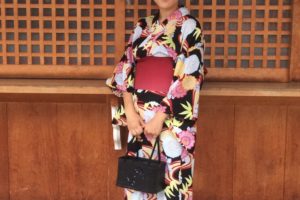Note: This is a snippet from my Japan 1-week itinerary which you can find in its entirety here
Ok the title is misleading – there’s not so much to ‘play’ with here. Koyasan’s (Mt. Koya) main draw is its peace and tranquility, a centre for Buddhist temples and temple lodgings.
The journey from Osaka to Koyasan may seem daunting if you’re looking at a route planner. There are four or five ‘changes’ but in fact, the changes are seamless. We took a train to Hashimoto, then onwards to Gokurakubashi, where we transferred onto a funicular in the tiny station for the leg up to Koyasan. Once in Koyasan, an army of public transport workers greeted us and directed us onto the right bus bound for our temple lodging. We stayed at Zoufukuin, which was a really beautiful temple that I found on Booking.com, right opposite the Reihokan museum. The entire town was so incredibly peaceful and serene, allowing you to stay right in the middle of nature without the discomforts of camping. The temperature was much cooler here too. On our first night, we visited two temples before dinner at 6pm. It was great that there was hardly anyone else around, as I find the overcrowding at religious historical sites often too much to bear.
Dinner was traditional shojin ryori, monks’ vegetarian food, filling and delicious. We wore the yukatas from our room to dinner, sat on little chairs at a low table and tucked into our individual feasts, all in perfect little wooden bowls and plates. We also had a large teapot of buckwheat tea with our meal, which consisted of pickles, rice, miso soup, seaweed, mushrooms, tofu and tempura root vegetables. The flavours were very delicate, some dishes were almost a bit too sweet for my palate, but still very enjoyable and no doubt highly nutritious. There was only one bathroom for the entire temple inn but luckily there were only two other guests staying, so scheduling bathtime was not a problem. There was a small but pristinely kept garden with running water flowing into a pond in the middle of the guests’ area, a relaxing touch. As there was no entertainment, and the environment was so tranquil, we were both asleep by 8pm.
The next morning started early, with a 6.40am prayers ceremony performed by monks of the temple. We then had another traditional meal for breakfast, this time with tofu and egg (I think – although it could have been beancurd too). We then headed out for a walk through Okunoin cemetery, all the way to the bridge where the monk who founded Koyasan as a mountain of worship centuries ago is still resting in eternal meditation. Down in the basement of the temple, there were hundreds of thousands of tiny buddhas, illuminated by thousands of lanterns. The path through the cemetery to get here was so incredibly beautiful, winding through stone plaques to the buried on our left and right. A group of Japanese grannies walked past us, beaming and chanting “ohaiyo gozaimas!” in unison, it was so sweet. Lots of little effigies and sculptures had miniature knitted hats on and red bibs, maybe to show that those spirits are not forgotten. There was one path that diverted from the main track, which we followed for a short while. As we were talking about how that particular path we were on could potentially be creepy at night (even though the rest of the cemetery was purely peaceful), we suddenly spotted drops of bright red blood on the stone tiles paved beneath us. These carried on all the way until the path reached a fork, where the drops of blood couldn’t be seen anymore, perhaps absorbed into the soil. There was also one section of the cemetery entirely dedicated to shrines for companies. Some of these statues and memorials here looked very expensive, including one for UCC coffee, a major coffee producer/cafe in Japan. We took the shorter route back to Zoufukuin, retrieved our bags and caught the bus to go back down the mountain and onto Odawara.

Go back to all Asia posts here



